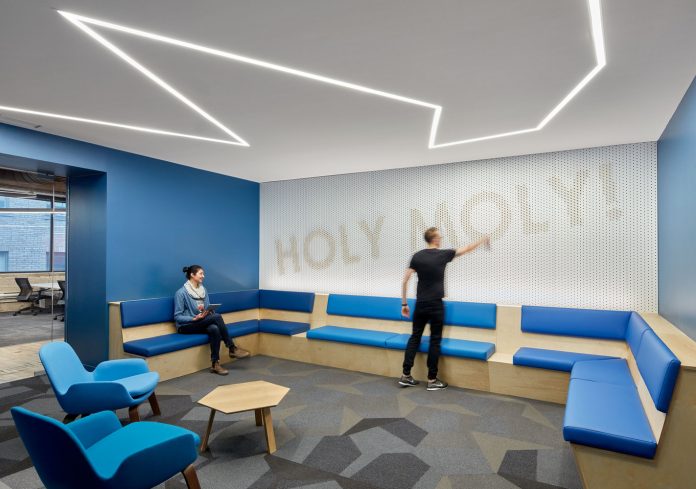As architectural designs have digressed from symmetrical and parallel mirroring patterns that align with vaulted ceiling, grid axis, and more; linear lighting allows architects to highlight asymmetrical architectural features and lines, aka architectural lighting. The lighting design trends of 2019-2020 have also moved towards asymmetry and no patterns.
Alcon’s co-founder David Hakimi has seen this trend approaching for a while—and welcomes it. “The beauty of lighting design right now is that there are very few limitations. We’re seeing some really creative and unique design patterns from architects using our custom-length commercial linear fixtures.”
Hakimi says one feature that makes these new fixtures so appealing is that they can be suspended or recessed on ceilings or walls in so many creative configurations.
Another factor that Hakimi predicts will boost the popularity of linear lighting in 2019 is the growing demand for new technological capability that allows lighting to be highly responsive and engaged as well as utilitarian.
For example, Hakimi says he’s already working with architects who are interested in using products equipped with the new Bluetooth Mesh technology.
Similar opportunities to use linear LEDs to “read” the needs of the people it is illuminating could be seen in department stores, which could use “connected lighting systems” both to help shoppers find specific products, and empower consumers to connect with the lights to find bargains or even dressing rooms.
Keeping up with it all drives entrepreneurs like those at Alcon to innovate. “We love when really imaginative architects call us and we’re able to meet their unique design layouts,” says Hakimi.
He cites another example. “The current trends with designers right now is using linear pendants and recessed fixtures in organic layout patterns unlike previously uniform ‘graph paper like’ patterns,” he explains. “We’re coming up with design solutions that no one was thinking about even a couple of years ago—but that make perfect functional sense today, rendering any application exciting and fresh.”
Among the growing trends Hakimi expects to see more demand for in 2019 are those that allow lighting to interact on a more personal level with the humans in a room.
“I’ve definitely seen the start of an RGB and Color-Tuning (Red, Green Blue — Color Changing) movement, using fixtures that produce a variety of colors to create moods and themes in both homes and offices at different times of the day.”
Want lights that can modulate depending on whether it’s sunny or cloudy outside? Need bright light when a meeting is happening but perhaps something more subdued with someone is working quietly? The lighting of 2019 will make those tech applications start to seem commonplace.
They’ll be “organic,” too—as in “organic design layouts.” That means less symmetry. Lighting designers are now spec’ing 2ft, 3ft, 5ft, and 6ft commercial linear pendants with no particular design pattern, instead of the standard rows of 4ft fixtures.
From architects who want to use these configurations to highlight the features and lines they love to draw into their designs, you’ll hear no complaints.
“Lighting is having a renaissance with both products and design concepts,” says Hakimi.
Hakimi believes there’s never been a more exciting or promising time to be involved in lighting design. With LED prices dropping, life span and warranties increasing, and consumer and business interest in “connected lighting systems” spiking, Hakimi says all eyes are on 2019, and the new lighting designs that no one may be thinking of right now—but that will seem totally “organic” when they occur.
Find a Home-Based Business to Start-Up >>> Hundreds of Business Listings.
















































